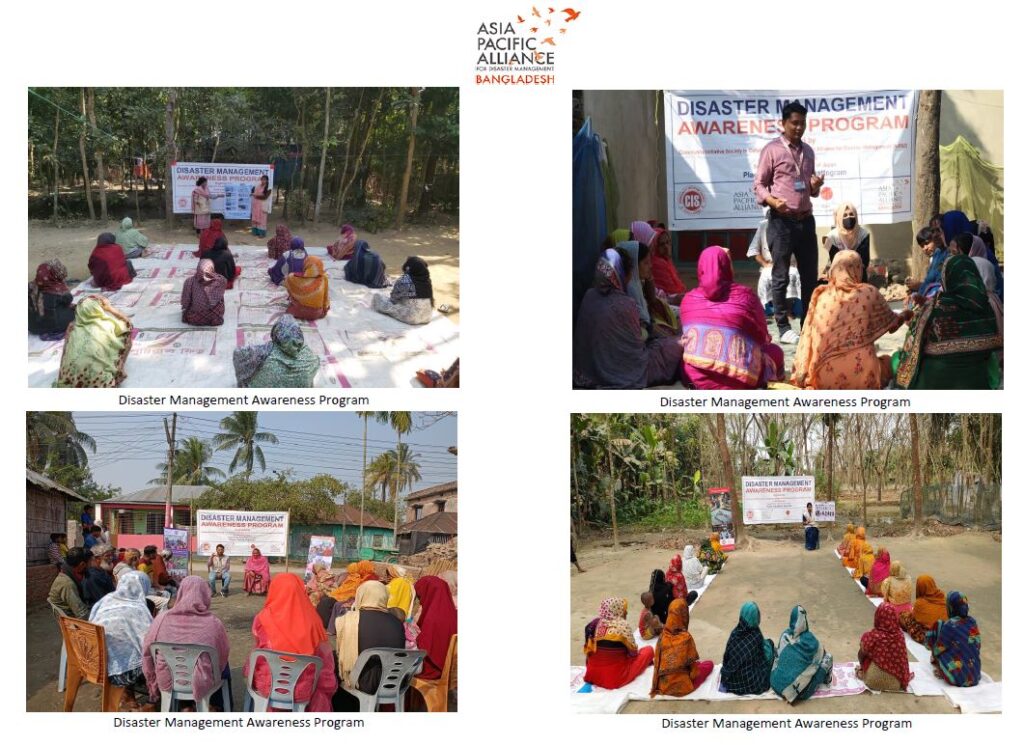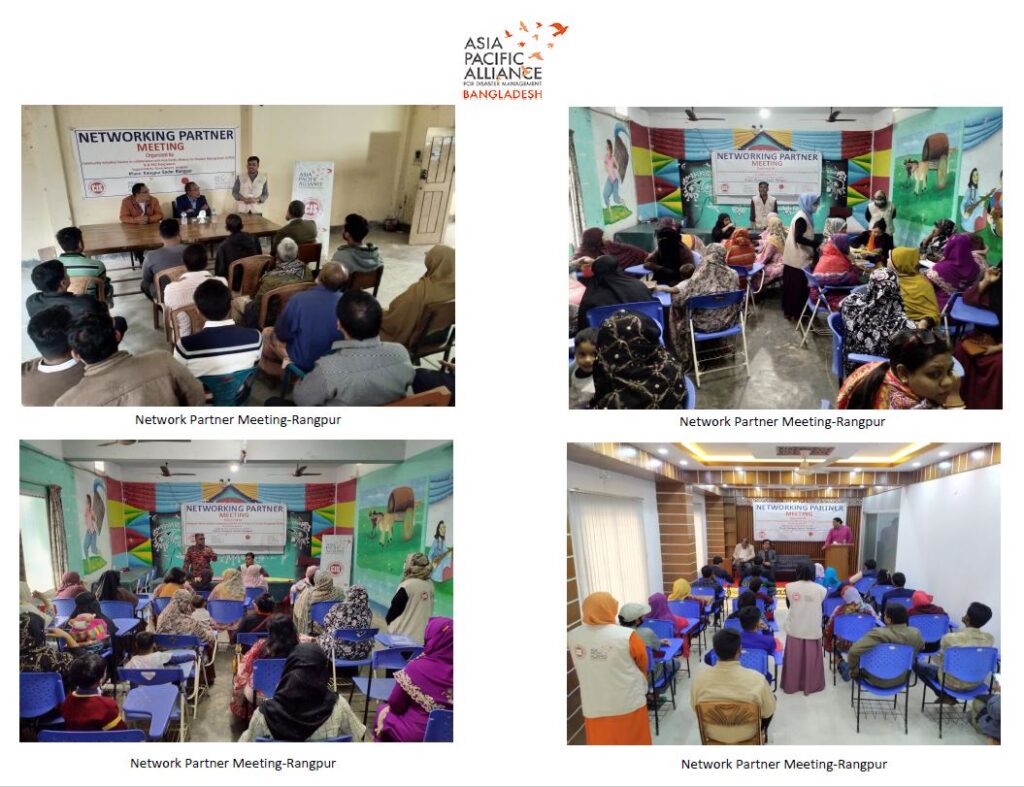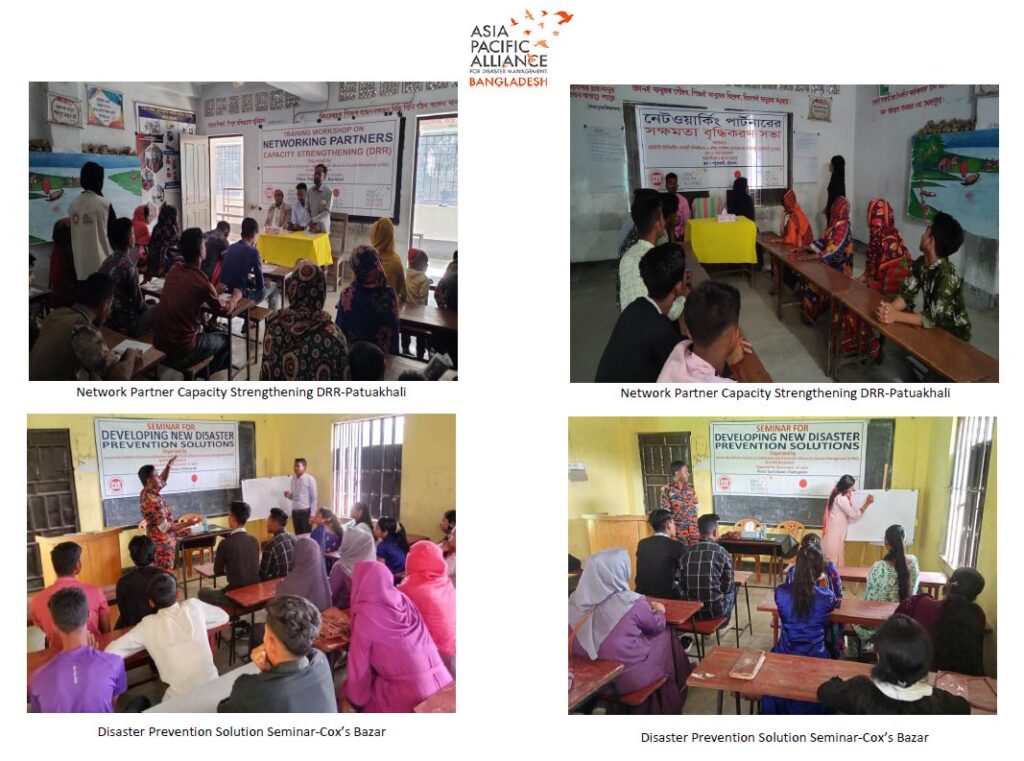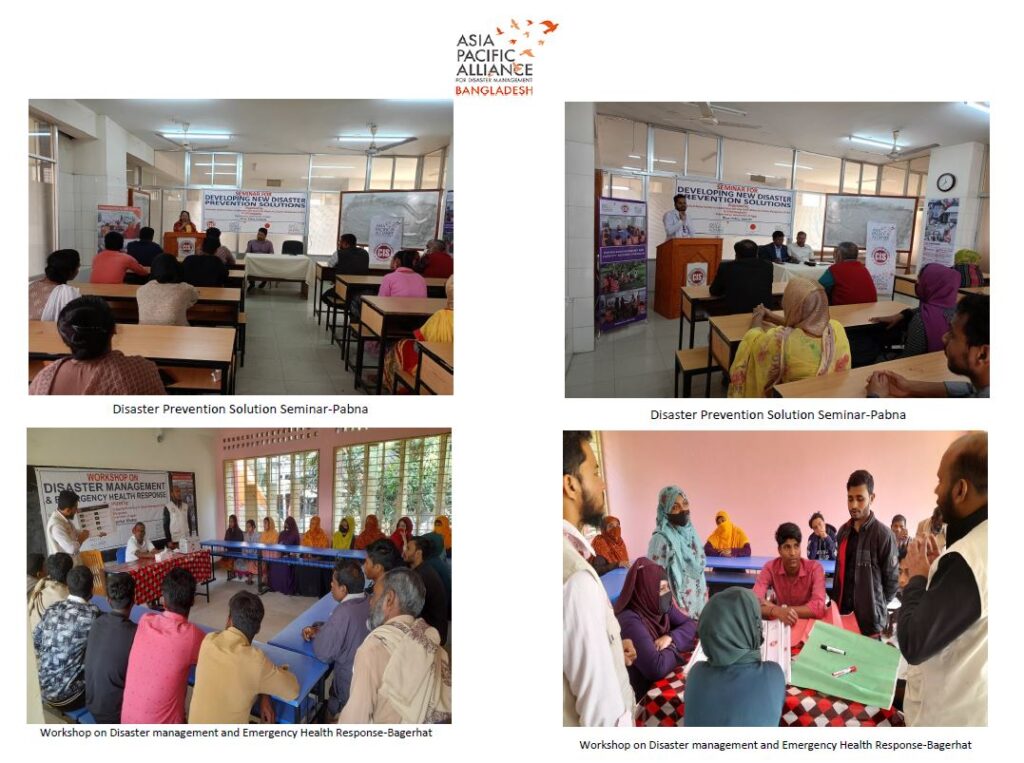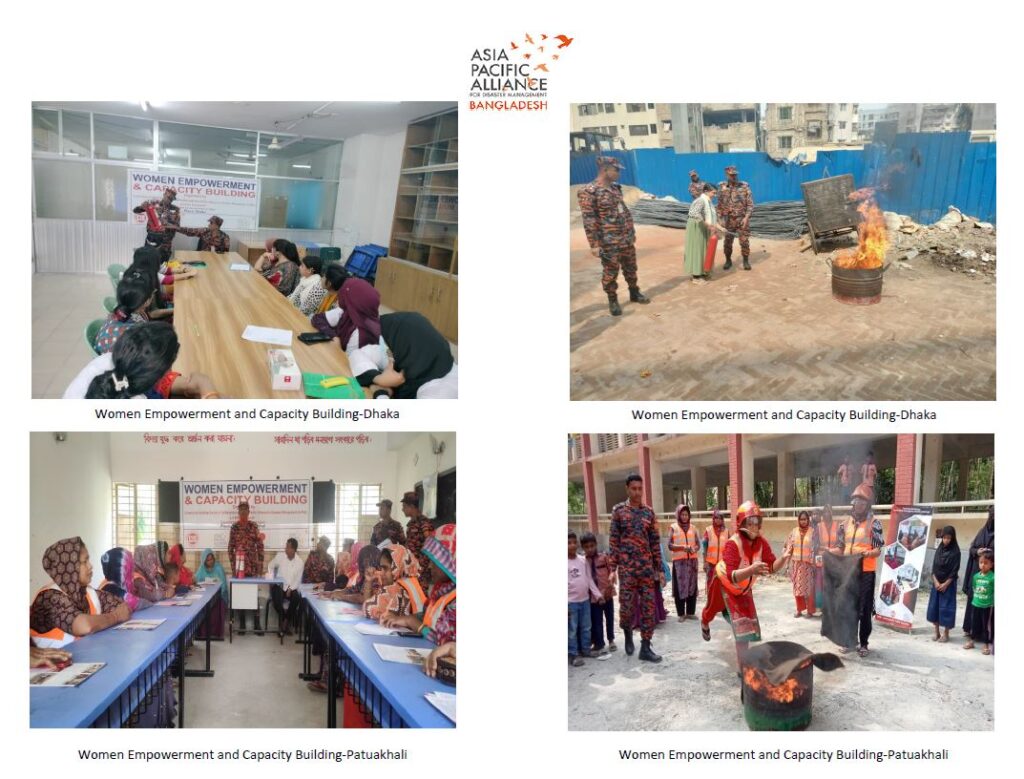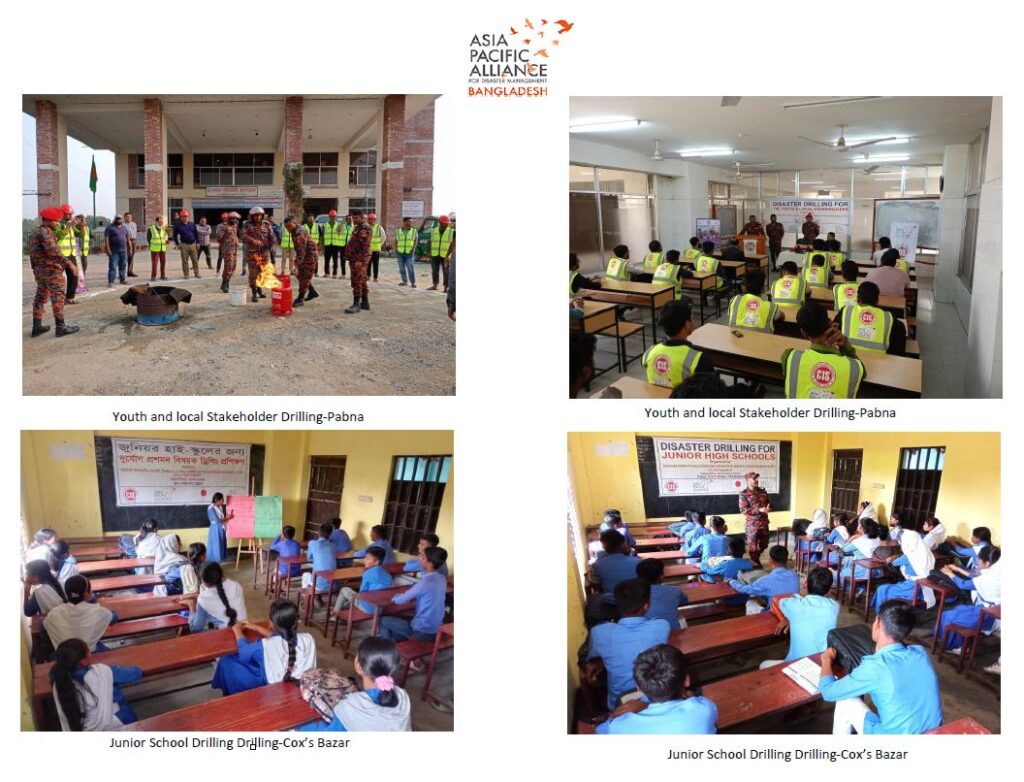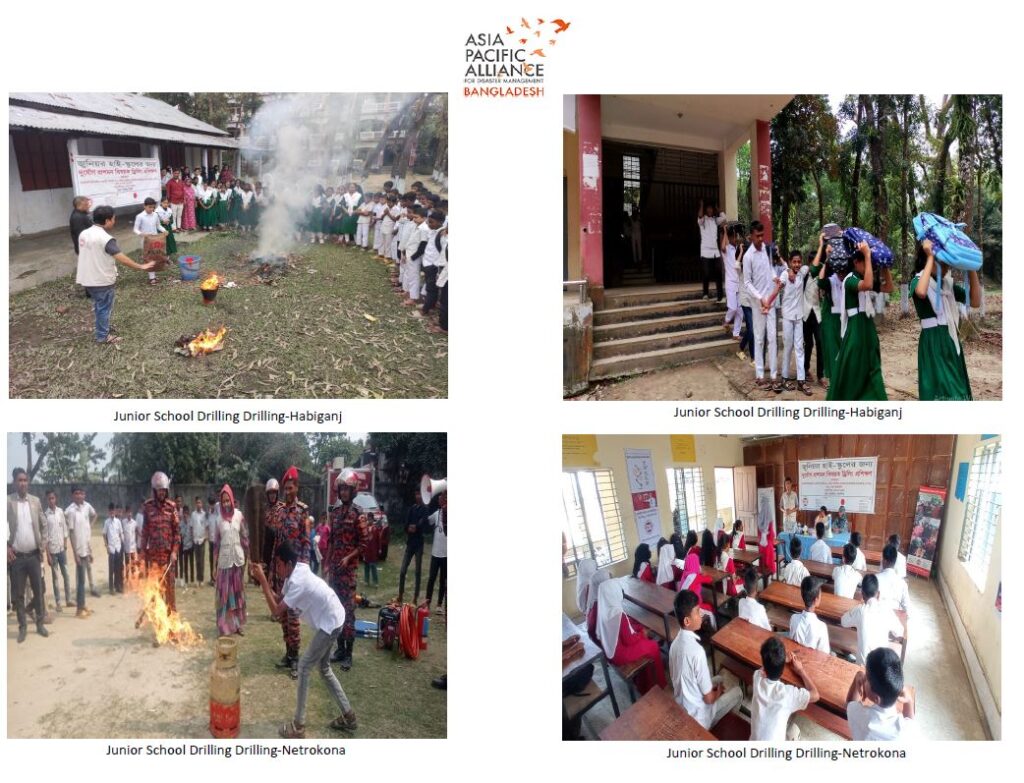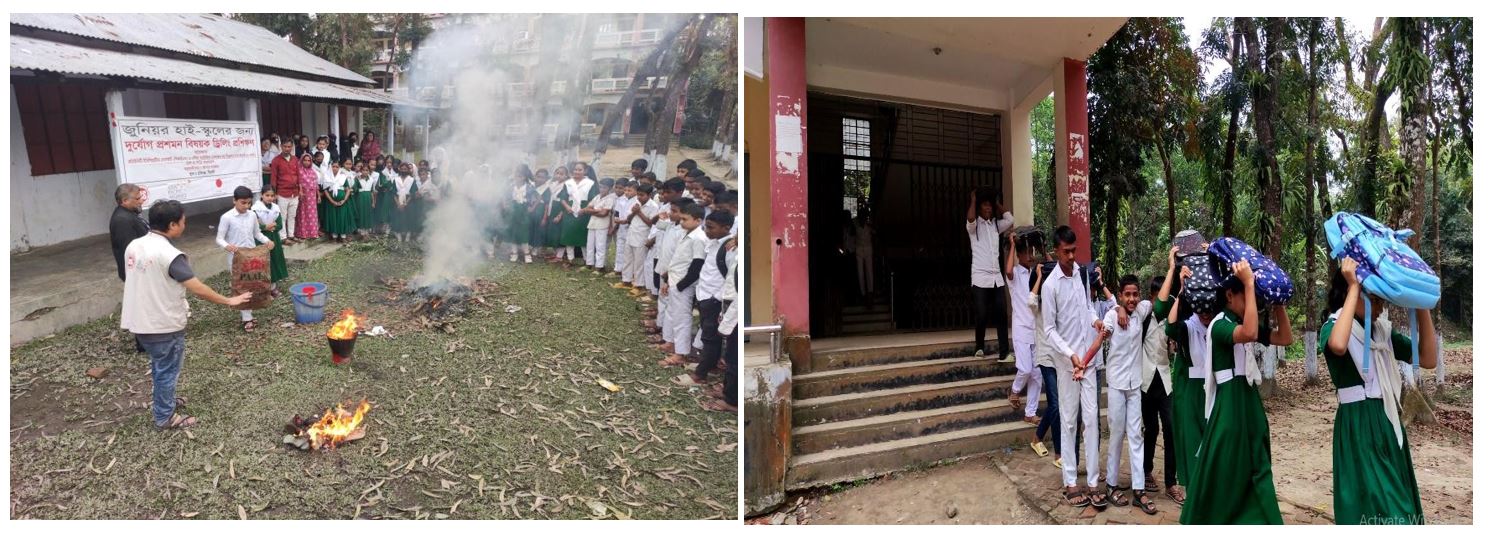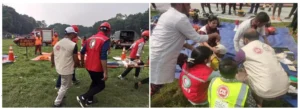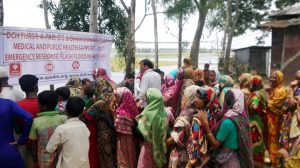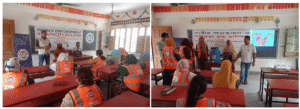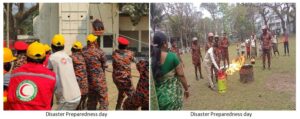A-PAD Bangladesh Activity Report Month of February 2024
Project Title: Strengthening Capacity for Sustainable Disaster Management Network by involving multi-sectoral platform Project Period: 17 January, 2024– 16 January, 2025 (12 month)
- Project Activities and Accomplishments
Bangladesh is ranking as one of the most disaster-prone countries. People in Bangladesh are often affected by water-related natural disasters, including floods, riverbank erosion and cyclones. In addition, recent rapid urbanization increases the risks for earthquake as well as man-made disasters. National Plan for Disaster Management (NPDM) 2021-2025 exemplified the strategic plan of the Government of Bangladesh in its Vision and the Mission of the Ministry of Disaster Management and Relief (MoDMR) between 2021 and 2025 towards building resilient nation. Bangladesh GOVT. has NPDM 2021-2025 has core goals for actions to save life, reduce economic losses in every disaster cycle stages which includes Disaster Risk Reduction (DRR), Humanitarian Response and Emergency Recovery Management. In Bangladesh most hazards impact: flood; cyclone and surge; tornado; earthquake; riverbank erosion; landslide; salinity intrusion; drought; tsunami; lightning; arsenic contamination; human-induced hazards and health hazards. The last hazard has potential for assuming significance because of the emerging risks in Bangladesh.
A-PAD Bangladesh started project from January 2023 and presently continue it 17 January 2024 to build up capacity on disaster management. It communicates with the different sectors like local community, community leaders, stakeholders, GOVT. officials continuing training on disaster management. To hold training program A-PAD Bangladesh staff organized small community meeting to sharing ideas on disaster and introduced them about A-PAD Bangladesh activity. A-PAD Bangladesh working 8 divisional areas.
There are 1 health workers in each divisions whose are doing home visit and aware the local community about basic disaster awareness. The health workers gave basic ideas about disaster management. A-PAD Bangladesh working at the rural areas. If there would be any directions or announcement from GOVT. or any disaster related news has been published the health workers delivered the message to the local community. Total 3,927 persons were benefited from A-PAD Bangladesh on February 2024.
A-PAD Bangladesh attended coordination meeting at the 8 divisions in Office of Deputy Commissioner. At that meeting different NGOs had joined and explained their activities. Besides this what will be the next activities of the GOVT. and NGOs were discussed at that meeting.
1. Strengthening of disaster risk reduction and disaster response system functions through the Emergency Disaster Management Coordination Center | ||
Activities | ( Outcome 1 ) The Emergency Disaster Management Coordination Center operated under this project will function as a disaster response base in each region, leading to the disaster risk reduction in the community and the strengthening of its disaster response system.: | Project Status: Achievements vs Outcome: If the activity is behind the schedule, please write the reason. |
1-1 Operation of Emergency Disaster Management Coordination Centers Target:Local communities 10 people×25 days×8 divisions×12 months =24,000 people | 【Indicators of Outcome】 1-1 The Emergency Disaster Management Coordination Center will be used for coordination meetings among partner organizations and relevant stakeholders during normal times, and will also serve as a center for health and public health guidance for the local residents. In the time of emergency, health services will be provided by emergency health workers. The Emergency Disaster Management Coordination Center will be used by 24,000 local residents (annual average) in the target area. (Indicator:number or visitors, record of services provided) 1-2 Through the Disaster Management Awareness Program, community residents will receive the latest disaster information and knowledge on how to respond to disasters, and people’s awareness of disaster prevention and response will be increased. (Indicator:Community disaster preparedness report) | Total 2810 people visited to the Disaster Management Coordination Center to discuss about disaster preparedness and health related issues. Dhaka: 335 Persons Cox’s Bazar: 347 Persons Pabna: 370 Persons Bagerhat: 358 Persons Patuakhali: 342 Persons Habiganj: 370 Persons Rangpur: 368 Persons Netrokona: 320 Persons Total = 2,810 Persons |
1-2 Disaster Management Awareness Program Target:Local communities, Community leaders, Local NGOs, Private company workers, government officials 15 people × 8 divisions × 4 times ×12 months =5,760 people | A-PAD Bangladesh conducted Disaster Management Awareness programs at the 8 divisional areas where 500 persons have participated. Total 4 times training organized at each divisional areas. Dhaka:15 Participantsx 4 Sessons= 60+2=62 Participants Cox’s Bazar: 15 Participantsx 4 Sessons= 60+5=65 Participants Pabna: 15 Participantsx 4 Sessons= 60+2=62 Participants Bagerhat: 15 Participantsx 4 Sessons= 60 Participants Patuakhali: 15 Participantsx 4 Sessons= 60 Participants Habiganj: 15 Participantsx 4 Sessons= 60+2=62 | |
|
| Participants Rangpur: 15 Participantsx 4 Sessons= 60+4=64 Participants Netrokona: 15 Participantsx 4 Sessons= 60+5=65 Participants |
2. Expansion of disaster management network to improve community vulnerability | ||
| (Outcome 2)The network of NPF will be expanded and the capacity of each region for disaster prevention and response will be strengthened. |
|
2-1 Network Partner Meeting Target : Local communities, Community leaders, Local NGO, Private Company Workers, Government officials 50 people × 5 villages × 8 divisions = 2,000 people | 【Indicator of Outcome】 2-1 Strategies, mechanisms, and action plans for disaster reduction cooperation are developed in each region through discussions at network partner meetings, and a framework for disaster reduction cooperation is established. (Indicator:Strategic Plan) 2-2 MOUs signed with at least 5 new organizations, including private companies, in A-PAD Bangladesh NPF to expand the network (Indicator:number of new MOUs signed) 2-4 Resources possessed by A-PAD BGD partner organizations are provided in emergency disaster response, and play the role of that organization in times of emergency. (Indicator:List of resources such as supplies, human resources and donations provided by partner | A-PAD Bangladesh organized 5 days Network partner Meeting at 5 villages in Rangpur. Total 258 participants has joined the meeting. 13 February 2024, Keranirhat, Total Participants 50+2=52 Participants 14 February 2024, Burirhat, Total Participants 50 Participants 15 February 2024, Shimulbag, Total Participants 50+3=53 Participants 28 February 2024, Nikhondho, Total Participants 50 Participants 29 February 2024, Lalbag, Total Participants 50+3=53 Participants The situation of vulnerable people is now aggravated by evolving, complex threats such as climate change, new patterns of marginalization, demographic growth and a rising proportion of older people, unplanned urbanization, high levels of violence, involuntary migration, emerging infectious disease and the growing burden of non- communicable disease, environmental degradation, and insecurity of access to food, water, and natural resources. |
| organizations for emergency disaster response) | In the network partner meeting A-PAD Bangladesh doing the strategic meeting with the different sectors Govt Officials, private organizations, NGOs, local communities. · Countries at high risk of natural hazards, food security and climate change will be identified, facilitating more targeted support to more communities. Risk reduction opportunities will also be further integrated into this support. · Cooperation and coordination modalities with Movement partners and other humanitarian actors will be better defined, to support National Societies in responding to natural disasters and complex emergencies · Technical assistance on disaster preparedness, relief and recovery with a focus on assessment, analysis, strategic planning, programming and learning will be provided as needed |
2-2 Disaster Preparedness Campaigns Target:Partner organizations and local communities 50 people × 2 times × 8 divisions = 800 people |
| |
2-3 Network Partners Capacity Strengthening (DRR) Target : Partner | A-PAD Bangladesh organized Network Partner Capacity Strengthening DRR at Patuakhali. 2 days training program organized where 43 participants joined at the training workshop. 10-11 February 2024, Patuakhali, total Participants 40+3 = |
organizations 20 people × 2 organizations × 2 times × 8 divisions = 640 people |
| 43 Participants NGOs have been working along with the government in rebuilding the country and realizing the nation’s aspirations. Eventually, arising from the institutional dynamics of a participatory approach to grassroots development, NGOs stepped into many other development sectors such as community capacity-building through health, education, water supply and sanitation, shelter and infrastructure, livelihood supports, nutrition, and environmental management. NGOs are also providing relief and rehabilitation supports to natural hazards-affected communities. Although the state is the leading actor integrating DRR (Disaster Risk Reduction) into policy strategies, the reformation of top-down governance in neoliberal societies and the government’s incapacity amplifies the scope of NGOs’ involvement in development. Disaster risk reduction (DRR) is a forward-looking strategy that seeks to reduce the impact of disasters by analyzing future disaster risk, making calculated predictions, assessing current vulnerabilities and building resilience. |
2-4 Seminar for Developing New Disaster Prevention Solutions Target : NGO, Disaster prevention related government organizations, Private sector personnels 30 people ( 2days ) × 8 divisions × 2 times = 480 people |
2 days seminar has been organized in Cox’s Bazar and Pabna. Total 65 participants from 2 divisional areas had joined the seminar.
13-14 February 2024, Pabna, Total participants 30+2=32 Participants 17-18 February 2024, Cox’s Bazar, Total participants 30+3=33 Participants |
|
| Disasters also have pervasive impacts on the society and have the potential not only to destabilise the economy, but also the access to education, livelihood opportunities, food security, housing and service provision (including healthcare). In Bangladesh, the impacts of flooding, cyclones, storm surges, landslides and droughts to a geographically unique and highly vulnerable ecological and human systems have led to a large-scale destruction of housing, land and property, and loss of livelihoods alongside increasing displacement and disaster-driven migration. Disasters also affect accessibility. Despite the urbanization trend and increasing infrastructure in Bangladesh, landslides, storms, flooding and earthquakes have the potential to significantly disrupt road networks, which then affects the ability to access shelters, healthcare, education and – on a wider scale – have implications on reducing poverty as poor access to markets are the cornerstones of livelihood generation · Ensuring that disaster risk reduction is a national and local priority with strong institutional basis for implementation; · Identifying, assessing and monitoring disaster risks and enhancing early warning; · Using knowledge, innovation and education to build a culture of safety and resilience at all levels; · Reducing the underlying risk factors; · Strengthening disaster preparedness for effective response at all levels |
2-5 International Symposium on DRR Target : Government, Local government, private company, NOG, partner organization, representative of A-PAD member countries, etc. 200 people |
|
|
3. Practical training to improve resilience of local communities | ||
| ( Outcome 3 ) Contribute to improving the disaster resilience of local communities through practical training. |
|
3-1 Disaster response capacity building of local community level in Health and hygiene field | 【Indicator of Outcome】 3-1 a) Establish networks of community leaders who can lead disaster response and emergency health response in all districts of Bangladesh. (Indicator:Number and the List of community leaders for disaster response/emergency health in each 8 districts.) b) Networks of human resources with the skills and know-how to respond to health emergencies will be established in all districts of Bangladesh to provide health services to the local residents in times of emergency. |
|
3-1 a) Workshop on Disaster Management and Emergency Health Response Target : Local residents, Community leaders, Local NGO workers 25 people ( 2 days ) × 8 divisions × 2 times = 400 | A-PAD Bangladesh conducted 2 days workshop at Bagerhat, total 25 participants joined the training workshop. 10-11 February 2024, Bagerhat, Total 25 participants
Concerning capacity building and public awareness raising it was acknowledged that efforts have been undertaken in the past and that the need for each country differs. Nevertheless, there is a need for training in several areas and the need for advancement of public education and | |
people | (Indicator:Data of NGO health personals who can respond in emergency. Number of residents who received the services in the cases of activities during emergency disaster in each 8 districts.) | awareness taking stock of good lessons already existing in the region. The DRR priorities are representing the immediate needs in the region to enhance the implementation of the CDM |
|
| strategy and the Sendai Framework in the contextual |
| 3-2 a) Disaster preparedness training and drills will be documented in a manual, and women, youth groups, and local stakeholders who participate in the drills will be granted certificates of completion and work as disaster volunteer teams during actual disasters. (Indicator:Drilling Manual, Cases of activities in emergency disaster response) | priorities. In this sense, countries and organizations working in Bangladesh can be guided by these areas identifying the focus of support. The priority areas and actions are an input to overall regional priorities. a. Early Warning Systems (EWS) b. Community Resilience c. Capacity Building, Training and Public Awareness d. Institutional Strengthening e. Private-Public Partnership |
| b) Disaster drills at junior high schools will be documented in a manual so that students who participate in the drills will have the skills to take appropriate action in the event of a disaster. (Indicator:Drilling Manual, Report of emergency disaster response) |
|
3-1 b) Training of Local Health Workers on Disaster Health Activities Target : Health workers who belong to local NGOs or civil organizations 20 people ( 3 days ) × 8 divisions = 160 people |
| |
3-2 Strengthening disaster response capacities of |
|
|
local communities |
|
|
through disaster | ||
drilling training | ||
3-2 a) | Two days drilling program organized in 2 divisional areas | |
Women Empowerment and | where 47 women has been joined the drilling program. | |
Capacity Building | 12-13 February 2024, Dhaka, Total Participants 20+4=24 | |
| Participants | |
Target : Women’s groups in target villages 20 people ( 2 days ) × 8 divisions × 2 times = 320 people | 13-14 February 2024, Patuakhali, Total Participants 20+3=23 Participants
Disaster management is a global challenge, but disasters do not affect men and women equally. In most of the world’s disasters, more females are impacted than males, and in | |
| Bangladesh the disparity between female and male victims | |
| is even greater. This study identifies and maps the | |
| relationships between the factors that make Bangladeshi | |
| rural women more vulnerable to natural hazard-induced | |
| disasters. | |
| Women’s work is heavily impacted by disasters, and their | |
| economic losses can be extensive. Domestic work increases | |
| enormously when support systems such Disaster response | |
| and family networks are disrupted or destroyed. Damaged | |
| living spaces are damaged working spaces for all women. | |
| Even in marginalized communities, natural disasters such as | |
| floods and cyclones have inspired women living in extreme | |
| poverty to take action and organize their own self-help | |
| initiatives. | |
3-2 b) | Youth and local stakeholder drilling program organized in | |
Disaster Drilling for the | Pabna where 50 participants joined. | |
Youth and Local | 27-28 February 2024, Pabna, Total Participants 45+5=50 |
Stakeholders Target:Youth in the local private and civic sector 45 people ( 2 days ) × 8 divisions × 2 times = 720 people |
| Participants Two days drilling program organize in collaboration with the Fire Service and Civil Defense in Panna. Mock exercises on various types of natural and anthropogenic hazards helps in inculcating a culture of preparedness and generate awareness. Mock exercises will help the government to assess the preparedness, review the crisis management system, Standard Operating Procedures and to evaluate the readiness of various departments to any disaster or emergency. Mock exercises will also give the opportunity to coordinate the activities of various agencies for their optimum utilization and to use the feedback to identify the gaps and improve the capacities of the system to face an actual disaster situation. · Assess the response mechanism of the first responders · Enhance coordination among the emergency support functioning agencies · Awareness creation among the participants. |
3-2 c) Disaster Drilling for Junior High Schools Target:School Children 40 people ( 2 days ) × 8 divisions × 2 times = 640 people | Disaster Drilling for Junior High School conducted in 3 Divisional areas. Total 129 participants joined the drilling program. 13-14 February 2024, Cox’s Bazar, Total Participants 40+4=44 Participants 17-18 February 2024, Netrokona, Total Participants 40+3=43 Participants 24-25 February 2024, Habiganj, Total Participants 40+2= 42 Participants In recent years, large-scale annual drills for earthquakes and other hazards have engaged |
|
| children in the continuous process of disaster preparedness. For schools, these drills have improved knowledge for disaster prevention, preparedness to respond and enhanced disaster plans and procedures. Before the drill, the students were sensitized about the emergency exit plan, evacuation routes, and the dos and don’ts that must be followed during an emergency. The purpose of the mock drill was also explained to the students, along with how it helps handle and prepare for unforeseen emergencies. They have also increased staff engagement in disaster planning in their own homes, encouraged them to seek training and reduced their exposure to physical risks. School fire drills have been credited with a significant reduction in fire-related injuries and deaths in school buildings. The sound of the horn was an indication for teachers and students to initiate the evacuation process. The students quickly moved towards the emergency exits and were supervised by vigilant teachers and admin staff. After the drill, a reflection time was conducted, where the students recollected all the steps to keep in mind during natural disasters. They reflected on the objective of the drill and what they had learned from the process. |
|
| · Consider solutions to problems that may arise during an emergency, such as a blocked evacuation route. • Discuss emergency response at home with their parents and other household members. Simple homework activities can be used to track if those discussions have occurred. • Learn the reasons for specific actions, and consider how their own behaviour can have a positive impact on community response |
3-3 Update website contents as E-resources for Disaster Management | 1. https://apad-bd.org/health-campaign-report/ 2. https://apad-bd.org/a-pad-bangladesh-activity-report- month-of-january-2024/ 3. https://apad-bd.org/wp-content/uploads/2024/03/1- 1.jpg 4. https://apad-bd.org/wp-content/uploads/2024/03/2- 1.jpg 5. https://apad-bd.org/wp-content/uploads/2024/03/3.jpg 6. https://apad-bd.org/wp-content/uploads/2024/03/4.jpg 7. https://apad-bd.org/wp-content/uploads/2024/03/5.jpg |
- Challenges
Please write Challenges and its impact upon the project implementation. (Ex. lockdown, Political situation, Curfew)
- Practice in collaboration with A-PAD Bangladesh Network Partners Please write good practice in collaboration with partner organizations
- Any contribution Funds Received and Grants Applied / Planned and Implemented Projects by CIS including Emergency Response
Please write Projects name and its fund resources
- Relationship with Bangladesh Government and Japanese Embassy
Please write about Meeting with Government officials
